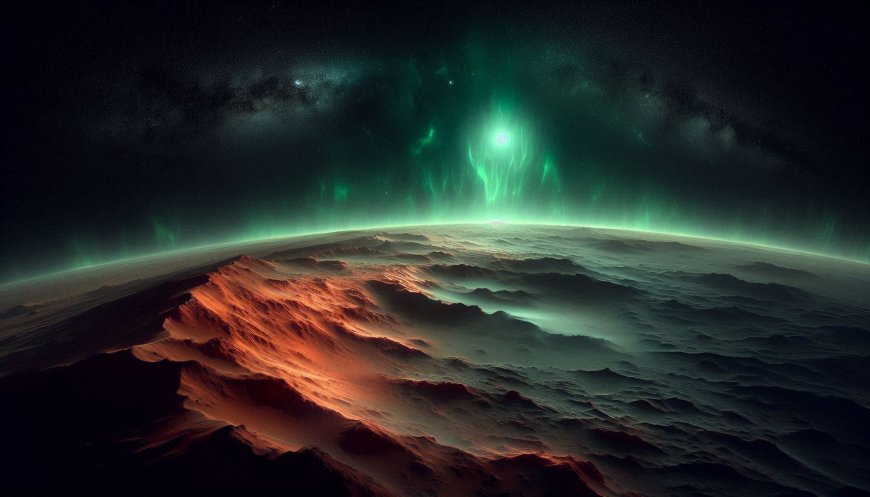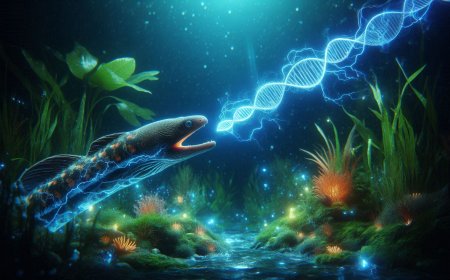Mars' Mysterious Nightlight: The Discovery of the Red Planet’s Green Glow
Discover the mysterious green glow of Mars, a fascinating phenomenon caused by oxygen in the red planet's atmosphere. Explore this eerie nighttime glow illuminating Mars' surface under the vast cosmic sky.

In a groundbreaking discovery, scientists at the University of Liège have captured something never before seen—a mysterious green glow radiating from Mars during the night. This celestial glow, invisible to the naked eye but caught by sophisticated instruments, sheds new light on the Red Planet’s atmospheric secrets and seasonal rhythms.
The Unveiling of Mars’ Green Glow
This fascinating find was made possible by the European Space Agency’s Trace Gas Orbiter (TGO), a satellite orbiting Mars as part of the agency’s ExoMars mission. Initially designed to observe ultraviolet light, the TGO’s UVIS-NOMAD instrument was repurposed by the University of Liège's team, led by Jean-Claude Gérard. By redirecting its gaze to Mars’ atmospheric edge, or limb, the team was able to capture the faint glow in the visible spectrum—a first in planetary exploration.
Hovering between 40 and 70 kilometers above the Martian surface, this glow originates from oxygen atoms high in the planet's atmosphere. These atoms, produced during the Martian summer, travel across the globe to the winter poles. When they combine with carbon dioxide molecules (CO2), they emit the distinctive green glow. “It’s like watching Mars breathe,” explains Lauriane Soret, a researcher at the Planetary Atmospheres Laboratory (LPAP).
A Dance of Martian Seasons
What makes this discovery even more remarkable is how the glow mirrors Mars’ seasons. Over the course of a Martian year—687 Earth days—the green light oscillates from one hemisphere to the other, following the planet’s summer and winter cycle. This rhythmic shift provides scientists with a rare opportunity to track atmospheric changes in real time, giving them insight into the complex dynamics of the Martian upper atmosphere.
For three years, researchers have been observing these seasonal patterns, uncovering new data on how winds carry oxygen atoms across Mars’ surface, only for them to converge and release their light at the poles. This ongoing research is crucial for understanding not only the planet’s atmospheric behavior but also how seasonal changes impact its overall environment.
Illuminating the Path for Future Explorers
Beyond its beauty, Mars' green glow may play a critical role in future exploration. The intensity of the glow could serve as a guide for astronauts navigating Mars from orbit or even from the surface. As Jean-Claude Gérard notes, “This could be a game-changer for future missions, offering real-time information about the planet’s atmosphere.” The ability to monitor Martian winds and atmospheric flows through this glowing phenomenon opens the door to more precise mission planning and deeper exploration of Mars’ climate.
Scientists are particularly excited about how these observations can help with remote sensing, allowing them to probe the composition of Mars' upper atmosphere without needing to send additional probes or landers. Benoit Hubert, another key researcher on the team, believes this method could revolutionize how we study planetary atmospheres in general, not just on Mars.
A New Frontier in Mars Exploration
The discovery of Mars’ green night glow marks a new chapter in our understanding of the Red Planet. While Mars has long been associated with its red hue, this green glow is a reminder of how much remains to be uncovered. It gives scientists a fresh perspective on Mars' atmospheric composition and behavior, offering clues about the planet’s ability to support human exploration in the future.
This first glimpse into the shimmering night skies of Mars provides a tantalizing preview of what’s yet to come. As the research continues, the glowing phenomenon could be the key to unlocking more of Mars' mysteries, helping humanity prepare for a future where astronauts walk the surface of this enigmatic planet. And who knows? Perhaps one day, those same astronauts will look up at Mars' green-tinted sky, knowing they are following in the footsteps of discoveries made from millions of kilometers away.
The green glow of Mars, once invisible, now stands as a beacon for all who dare to explore the final frontier.
What's Your Reaction?








































































































